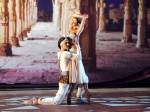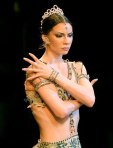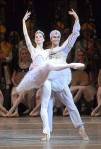“I have seen a proper ballet!” was the thought that came to my mind as I was walking out of the cinema last Sunday. Not that I hadn’t before, but it really satisfied my hunger for a good ballet production.

from website http://scalaprestatyn.co.uk
I often say that a ballet company’s level is reflected by how good the corps de ballet is. The corps today was simply fantastic! By the time all thirty-two girls arrived in their positions after the famous (infamous for dancers!) sequence of arabesques down several ramps and across the stage, the audience gave them a hearty applause, and did they deserve it! The very first dancer to appear on stage has to do a whopping forty-six set sequence of arabesques! None of the thirty-two very long legged dancers showed wobbles or mistakes. Their timing was impeccable. At one point, all thirty-two were balancing very still in fifth position en pointe and in perfect synchronicity moved their arms upwards very slowly. It was as if they were one dancer superimposed multiple times.
It can be very frustrating for young dancers who want to join big prestigious companies such as Bolshoi Ballet, Mariinksy Ballet and Paris Opera Ballet, but as a member of the audience, I can see why these companies are very reluctant to accept outsiders. Such impressive and consistent lines are brought out only by the same education and the same exact style in the way they dance; the dancers’ physiques which are second to none are also due to the same education.
It was not only the corps de ballet that maintained the very high standard of the Bolshoi.
Vladislav Lantratov, who was recently promoted to the rank of Leading Soloist, danced the part of Solor very confidently. His technique was very secure, his manner caring and dignified and he made a strong partner. He was cast opposite two of the top principal dancers, Svetlana Zakharova and Maria Alexandrova, and did not look at all fazed. I very much like this dancer and am looking forward to seeing more of him in due course.
Lantratov also showed his emotional turmoil very effectively during his pas de deux with Gamzatti (Alexandrova). Many dancers dance this pas de deux without showing the slightest sign of remorse and that does not make me feel sympathetic towards them. When the Rajah told Solor that he is to wed his daughter Gamzatti in the first act, Lantratov showed every sign of refusing despite the obligation he was under. But on seeing Gamzatti, he was thrown by her beauty and the expression he showed at that moment was excellent. One could see that he was torn between his true love and a new beautiful woman for whose father he felt a strong obligation to serve and be faithful.
Maria Alexandrova was the very best Gamzatti I have seen! Her technique was very strong and clear-cut, but more than anything, her interpretation of the role of Gamzatti touched me. She was not a cold-hearted woman who wants to eliminate her rival regardless of the method. She was like an innocent little child who has never been denied anything in her life. Gamzatti also is in love with Solor and cannot understand why Nikiya does not give up Solor when she asks her to. She is so true to her own heart. In this production, it was very clearly her father, the Rajah who ordered the flower basket with a venomous snake, and Gamzatti gets clearly very distressed at the sight of Nikiya’s agony.
In the Paris Opera Ballet’s version by Nureyev, it is Gamzatti who orders Nikiya be killed and when Nikiya accuses her of the plot, she quite coldly admits it. Although in other productions such as those of the Royal Ballet (Makarova) and the Mariinsky, Gamzatti does not quite admit that it was she who planned the kill, in neither production does she deny her involvement. I always thought this was very odd. Why would she, if she was so cold and calculating as to order Nikiya to be killed, not lie to Solor about it?
Alexandrova’s Gamzatti was not cruel or calculating. She just followed her heart. She truly wanted Solor and was so excited and smitten with him. She looked at him so trustingly and was so full of joy during the pas de deux that it made a fantastic contrast with Lantratov’s Solor.
Anton Savichev who was Magedaveya, the Fakir, was light and precise with his jumps and looked as good as he could in loincloth and long wig. Anastasia Stashkevich danced the first solo in the Kingdom of Shades with very strong technique that made the audience gasp. Anna Antropova, Vitaly Biktimirov and Igor Tsvirko were passionate and exciting in the Dance with Drum and it was a shame it was such a short dance. They brought a smile to my face and made me want to dance again.
Accompanying such a high standard of dancing was the beautiful scenery. In the first act, the scene is at a temple in the middle of a jungle. The sacred fire burns in the middle which casts a warm orange glow around it but the rest of the stage is lit by blue lights. There was a body of water at the back which seemed to reflect the moonlight and the blue light moved as though the surface of the water was rippling slightly. It was very atmospheric and the water theme worked so well as a contrast to the fire. In the last act, the Kingdom of Shades, the dancers come down four rather steep ramps so although it is no doubt hard for the dancers, the audience gets to see a very impressive descent of the shades from the mountain.
I was also rather relieved to see that the costumes of the shades were quite simple white ones. Traditionally they have a white veil attached to their hair with the end attached to their wrists but no other headdress. However, in some recent productions, costumes have started to become more and more elaborate with lots of glitter and extra head gear, of course with even more glitter. For many ballets I find them perfectly fitting and pretty. For the “white ballets”, however, I would rather they did not use any glitter at all. When I look at thirty-two swans lined up in the second act of Swan Lake, the wilis in the second act of Giselle, the sylphs in Chopiniana (as Les Sylphides is called in Russia) – and of course the shades in the Kingdom of Shades scene in La Bayadere – I find glitter and extra decoration more of a distraction than anything else. Overly decorated and glittering costumes break the sense of unity of the Corps.
The Bolshoi Ballet and Mariinsky have always had very simple white tutus with the minimum of decoration for their white ballets. It might just be their statement of how much confidence they have in their dancers and how little need they feel to cover anything up. They just want to show off their dancers above all else. And why spoil perfection?




